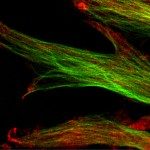Lien vers Pubmed [PMID] – 17346745
J. Mol. Biol. 2007 Apr;368(2):464-72
Sperm whale myoglobin can be considered as the model protein of the globin family. The pH-dependence of the interactions of apomyoglobin with lipid bilayers shares some similarities with the behavior of pore-forming domains of bacterial toxins belonging also to the globin family. Two different states of apomyoglobin bound to a lipid bilayer have been characterized by using hydrogen/deuterium exchange experiments and mass spectrometry. When bound to the membrane at pH 5.5, apomyoglobin remains mostly native-like and interacts through alpha-helix A. At pH 4, the binding is related to the stabilization of a partially folded state. In that case, alpha-helices A and G are involved in the interaction. At this pH, alpha-helix G, which is the most hydrophobic region of apomyoglobin, is available for interaction with the lipid bilayer because of the loss of the tertiary structure. Our results show the feasibility of such experiments and their potential for the characterization of various membrane-bound states of amphitropic proteins such as pore-forming domains of bacterial toxins. This is not possible with other high-resolution methods, because these proteins are usually in partially folded states when interacting with membranes.
